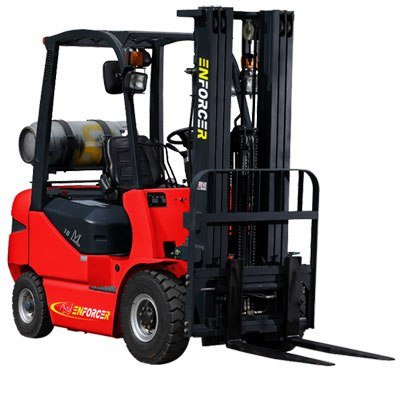There are many different types and brands of forklift propane tanks available in the market today. They can be classified by their weight, the type of materials, and the amount of fuel they hold.
You might be asking how heavy a forklift propane tank is. Well, below is a table that specifies how heavy it is and the capacity it can hold.
| Weight & Capacity | 33# Steel | 33# Aluminum | 43# Steel | #43 Aluminum |
| When Empty (in kg./lb.) | 35/15.87 | 23/10.43 | 40/18.14 | 27/12.25 |
| When Full (in kg./lb.) | 69/31.30 | 56/25.40 | 83.5/37.87 | 70.5/31.98 |
| Capacity It Can Hold (gallon/liter) | 7.9/29.90 | 7.9/29.90 | 10.3/38.99 | 10.3/38.99 |
Please remember that these figures are what most standard forklift tanks have. If your business use larger capacity tanks, consult the manufacturer for the exact weight, size and specifications that you might need. (we would like to give credit to propane101.com for the figures)
Weight of the Tank Does Affect Efficiency
Steel tanks are much heavier than aluminum. With the additional weight, it is much harder for operators to exchange tanks and less efficient for the forklift.
This is the main reason why most businesses opt in purchasing aluminum because this material is lighter than steel.
This subtle difference in the material has a great effect on efficiency especially if the fleet is large and if the business oper ates round the clock.
ates round the clock.
Operator Training in Tank Handling Must Be Given
Operator training is also necessary to meet efficiency and to protect the workers from getting injured. Propane tank handling must be part of the training curriculum or given as a separate course.
If the business has a large number of operators and maintains a big fleet of propane-powered forklifts, it is recommended to give propane tank handling training as a separate course.
With supplemental operator training, it is expected that unsafe operator behavior will be corrected and best practices will be implemented that include proper tank handling to meet productivity.
Steel Versus Aluminum Tank
Propane tanks come in two types: steel and aluminum. Each tank holds approximately eight gallons of propane.
Steel tanks are heavier than aluminum tanks, but they are more durable. They do corrode and they can withstand higher temperatures. Steel tanks are also a little bit more expensive than aluminum tanks, and they require more maintenance because the steel is prone to rust and corrosion.
On the other hand, aluminum tanks are lighter than steel, which makes them easier to carry around the warehouse or factory floor and store. They can be an excellent choice for businesses that have a large fleet. The aluminum type is what most operators prefer to handle because of its ease to use and exchange.
What Do You Need for Your Business
The type of forklift tanks you need for your business would depend on your preference. Those businesses that have a large fleet of trucks and operate 24x7 might need bigger capacity tanks that can last longer to get the job done without interruption.
If you run a small fleet, however, you might think that having smaller capacity tanks on your trucks is better, at least in a financial aspect, but those tanks tend to run out of gas in a shorter amount of time and thus need to exchange more frequently, resulting in operation interruption.
The other consideration you need to take note of is the tank mounting bracket on the vehicle because most are constructed for specific cylinder sizes. In some types of forklifts, mounting brackets are designed for small size tanks and for vertical mounting while most forklifts do utilize horizontal mounting.

